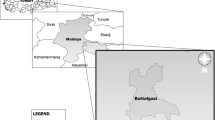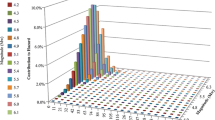Abstract
This paper focuses on a geophysical-based analysis of the soils in Arica and Iquique, both main cities in northern Chile. The large seismogenic coupling and the 136-year seismic gap predispose the north of the country to the highly likely seismic activity that could affect this area. This seismotectonic scenario highlights the importance of the assessment of earthquake hazards in urban domains. In this context, seismic microzoning emerges as a tool to identify areas that are more or less susceptible to ground motion amplification. In both cities, 148 sites were chosen to perform geophysical surveys based on surface wave methods, namely the spatial autocorrelation, frequency-wave number and H/V spectral ratio techniques. By inverting the measurements, local shear wave velocity profiles and predominant frequencies were derived. Additionally, seven boreholes were drilled to further complement the gathered data. With the available results, the cities were subdivided into different zones with similar properties in terms of the average shear wave velocity on the upper 30 m (\(V_\text{s}^{30}\)) and the predominant site’s frequency \(F_0\); these were parameters that were found consistent with the geology of each city. The collected information suggests zones that are more prone to ground motion amplification, namely: the northern side of Arica, the south-east area of Iquique, the northern limit of Iquique and the artificial landfill of the port of Iquique. The microzoning was compared to the ground motion records of the April 1, 2014, Iquique earthquake and showed to be consistent with the expected motion amplification in Iquique.











Similar content being viewed by others
References
Acerra C, Aguacil G, Anastasiadis A, Atakan K, Azzara R, Bard P-Y, Basili R, Bertrand E, Bettig B, Blarel F et al (2004) Guidelines for the implementation of the h/v spectral ratio technique on ambient vibrations measurements, processing and interpretation 169(December):1–62
Aki K (1957) Space and time spectra of stationary stochastic waves, with special reference to microtremors. Bull Earthq Res Inst 35:415–456
Astm D (2011) 2487–00 standard classification of soils for engineering purposes (unified soil classification system). Annual Book of ASTM Standards, Section 4
Bettig B, Bard P, Scherbaum F, Riepl J, Cotton F, Cornou C, Hatzfeld D (2001) Analysis of dense array noise measurements using the modified spatial auto-correlation method (SPAC): application to the grenoble area. Boll Geofis Teor Appl 42(3–4):281–304
Chavez-Garcia FJ, Cuenca J (1998) Site effects and microzonation in acapulco. Earthq Spectra 14(1):75–93
Chavez-Garcia FJ, Rodriguez M, Stephenson WR (2005) An alternative approach to the SPAC analysis of microtremors: exploiting stationarity of noise. Bull Seismol Soc Am 95(1):277–293
Chávez-García FJ, Rodríguez M, Stephenson W (2006) Subsoil structure using spac measurements along a line. Bull Seismol Soc Am 96(2):729–736
Chlieh M, Perfettini H, Tavera H, Avouac J-P, Remy D, Nocquet J-M, Rolandone F, Bondoux F, Gabalda G, Bonvalot S (2011) Interseismic coupling and seismic potential along the central andes subduction zone. J Geophys Res Solid Earth (1978–2012), 116(B12)
Comte D, Pardo M (1991) Reappraisal of great historical earthquakes in the northern Chile and southern Peru seismic gaps. Nat Hazards 4(1):23–44
Deere DU, Miller R (1966) Engineering classification and index properties for intact rock. Technical report, DTIC Document
García M, Gardeweg M, Clavero J, Hérail G, de Geología y Minería SN (2004) Hoja arica, región de tarapacá. Servicio Nacional de Geología y Minería, Santiago, Chile
Humire F, Sáez E, Leyton F and Yañez G (2015) Combining active and passive multi-channel analysis of surface waves to improve reliability of vs30 estimation using standard equipment. Bull Earthq Eng 13(5):1303–1321
Kvaerna T, Ringdahl F (1986) Stability of various fk estimation techniques. Norsar Semiannu Tech Summ 1:1–86
Lacoss R, Kelly E, Toksöz M (1969) Estimation of seismic noise structure using arrays. Geophysics 34(1):21–38
Leyton F, Ruiz S, Sepúlveda S, Contreras J, Rebolledo S, Astroza M (2013) Microtremors’ hvsr and its correlation with surface geology and damage observed after the 2010 maule earthquake (Mw 8.8) at talca and curicó, central Chile. Eng Geol 161:26–33
Maldonado G (2014) Caracterización geológica de los suelos de fundación de la ciudad de Arica. XV región de Arica y Parinacota. Universidad Católica del Norte
Marquardt C, Marinovic N, Muñoz V (2008) Geología de las ciudades de iquique y alto hospicio, región de tarapacá. Carta Geol Chile Ser Geol Básica 113:33
Nakamura Y (1989) A method for dynamic characteristics estimation of subsurface using microtremor on the ground surface. Q Rep Railw Tech Inst 30:25–30
Park CB, Miller RD (2008) Roadside passive multichannel analysis of surface waves (MASW). J Environ Eng Geophys 13(1):1–11
Park CB, Miller RD, Xia J (1999) Multichannel analysis of surface waves. Geophysics 64(3):800–808
Pilz M, Parolai S, Picozzi M, Wang R, Leyton F, Campos J, Zschau J (2010) Shear wave velocity model of the santiago de Chile basin derived from ambient noise measurements: a comparison of proxies for seismic site conditions and amplification. Geophys J Int 182(1):355–367
Roma V, Tononi C (2011) Masw-remi method for seismic geotechnical site characterization: importance of higher modes of rayleigh waves. In: 12th international congress of the brazilian geophysical society
Scholz CH, Campos J (2012) The seismic coupling of subduction zones revisited. J Geophys Res Solid Earth (1978–2012) 117(B5)
Scott JB, Rasmussen T, Luke B, Taylor WJ, Wagoner J, Smith SB, Louie JN (2006) Shallow shear velocity and seismic microzonation of the urban Las Vegas, Nevada, Basin. Bull Seismol Soc Am 96(3):1068–1077
Tokimatsu K (1997) Geotechnical site characterization using surface waves. In: Proceedings of 1st international conference on earthquake geotechnical engineering, vol 3, pp 1333–1368
Tuladhar R, Yamazaki F, Warnitchai P, Saita J (2004) Seismic microzonation of the greater bangkok area using microtremor observations. Earthq Eng Struct Dyn 33(2):211–225
Wathelet M (2008) An improved neighborhood algorithm: parameter conditions and dynamic scaling. Geophys Res Lett 35(9):L09301
Wathelet M, Jongmans D, Ohrnberger M, Bonnefoy-Claudet S (2007) Array performances for ambient vibrations on a shallow structure and consequences over Vs inversion. J Seismol 12(1):1–19
Acknowledgments
This research was partially supported by a Grant from the Chilean National Commission For Scientific and Technological Research, under FONDEF + ANDES Award Number D10I1027 and partially by the National Research Center for Integrated Natural Disaster Management CONICYT/FONDAP/15110017. We would also like to thank the National Office of Emergency (ONEMI) for contributing with the records of the April 1, 2014, Iquique earthquake.
Author information
Authors and Affiliations
Corresponding author
Rights and permissions
About this article
Cite this article
Becerra, A., Podestá, L., Monetta, R. et al. Seismic microzoning of Arica and Iquique, Chile. Nat Hazards 79, 567–586 (2015). https://doi.org/10.1007/s11069-015-1863-y
Received:
Accepted:
Published:
Issue Date:
DOI: https://doi.org/10.1007/s11069-015-1863-y




